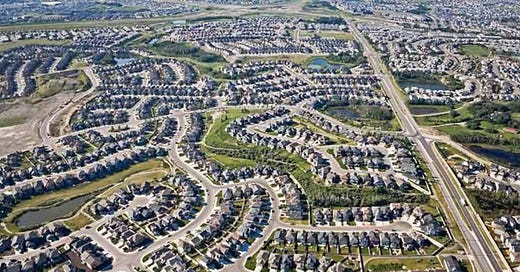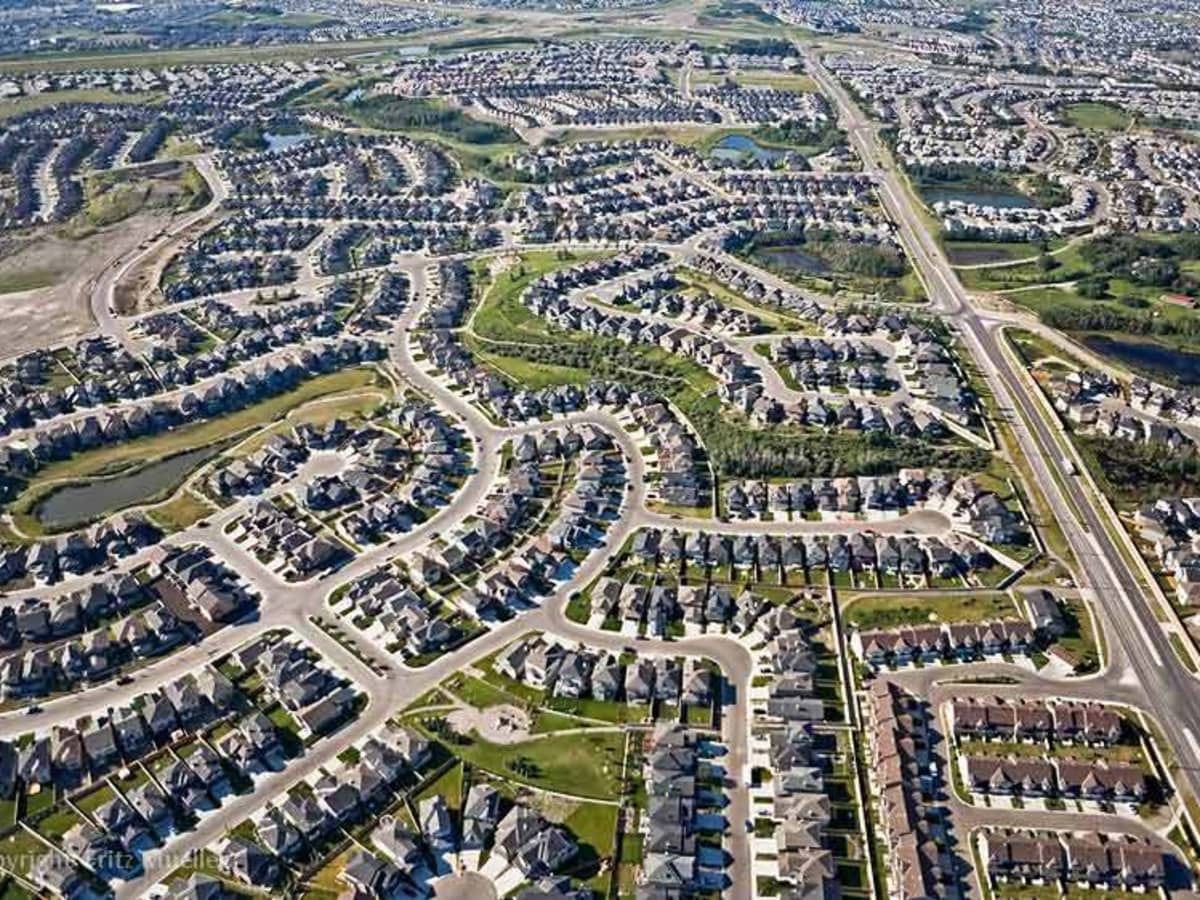We need to stop fighting urban "sprawl"
and start making housing affordable again.
In a previous excerpt, I made the case that unaffordable housing is one of the Western world’s biggest problems, and it has emerged only recently due to bad government policy. In another excerpt, I made the case that YIMBYs are only 50% correct, because they view urban sprawl as something to be fought against and urban density as something to aspire to. Sprawl is typically defined as the spreading of urban developments onto undeveloped land near the city.
Sprawl Is Not Bad
A big part of the problem is the goal of urban planners. While we might consider urban design to be a pure type of engineering, urban design has always gone through wild swings in design philosophy.
Today, virtually all urban planners regard “sprawl” as something that cities desperately need to avoid. These urban designers view the dense metro areas in Europe and the United States of the late 19th and early 20th Century as the ideal urban form. They effectively view “density” as one of their prime design goals, though they also often use the term “livable” and “walkable” in its place.
Urban planners also regard “affordable housing” and “government-subsidized housing” as synonymous. The idea that builders should be free to construct homes on the outskirts of a metro area as it grows in population is entirely foreign to their worldview.
Most of the following is an excerpt from my second book Promoting Progress: A Radical New Agenda to Create Abundance for All. You can order my e-books at a discounted price at my website, or you can purchase full-price ebooks, paperback, or hardcovers on Amazon.
Other books in my “From Poverty to Progress” book series:
This post is part of a multi-post series on Housing:
We need to stop fighting urban “sprawl” (this article)
Sprawl is the inevitable outcome of economic development. As people get wealthier, they naturally want to have more space to live in. That is why there are very strong differences in urban density between developing nations and developed nations.
It is also why there is a very clear trend within those groups as well.
Sprawl, or the geographical expansion of urban areas, is critical to keeping land prices affordable. And when land is affordable, housing is affordable. The actual cost of materials and labor varies relatively little between metro areas. It is the cost of land and government regulations that varies. And it is the working class and lower class that pay the price for these policies.
These urban growth boundaries force builders to construct houses and rental units inside the boundary, where land is artificially expensive. These boundaries and other regulations force builders to build up. This sounds good until one realizes that this dramatically increases the cost per square foot. These additional costs effectively make it illegal to build housing that can be sold on the market for affordable prices. Even with heavy government subsidies, the higher construction costs guarantee unaffordable selling prices (Arenson)
Metro areas with urban containment zones sort people into “Haves” and “Have nots.” These regions have a professional class that owns homes that are rapidly increasing in value. The value of their home allowing for their mortgage balance often reaches hundreds of thousands of dollars. Forced density subsidizes the investment portfolio of the professional class.
Metro areas with urban containment zones also have youths and renters who are struggling. Some older members of the working class were fortunate enough to have bought into the market when prices were lower, but younger members of the working class are priced out of the market.
.
It should not be a surprise that the very same people who object so vehemently to sprawl are homeowners in affluent neighborhoods in cities with highly expensive housing. Sprawl is not a fundamental threat to the environment; sprawl is a fundamental threat to their investment portfolio.
The goal of these urban design policies was to increase density, but as Shlomo Angel’s major work on the subject shows, they failed in that goal. In all nations, cities are becoming less dense, not denser, despite every effort from urban planners. Unfortunately, all these urban designers succeeded in doing was creating dangerous distortions in our economy (Angel).
We Are Not Running Out of Land
It is often claimed that we need urban density because we are running out of land. Many people claim that containing the spread of urban areas is the only way to preserve what little wild habitat and agricultural land we have left. In reality, the United States is not running out of land for cities any time soon.
Few Americans realize just how little land is devoted to cities. Satellite data and GIS mapping show urban areas, including their transportation infrastructure, take up only about 3.2% of the land within the United States excluding Alaska (Fischel). Even doubling the urban land area, which is not very likely under any scenario, would lead to little change in the balance between urban areas and wildlands. Any expansion of urban areas would likely come at the expense of agricultural land, either for farming or ranching.
Professor William A Fischel, an expert in the field, routinely presents his students of urban economics with the following thought experiment: Divide the current U.S. into households of persons and house them on plots of land equal to one acre per household (a size of land plot that is much higher than most Americans own). What percentage of the total land area of the United State would be covered? Virtually no students guess under 10%, while the median answer is 30-40%. Even urban planners at conferences are just as far off in their estimates (Fischel).
If affordable housing at market prices were widely available, then I could see the argument for constraining urban expansion. But with urban housing becoming less and less affordable, these constraints are a very bad trade-off.
Slower Economic Growth
There is clear evidence that government-forced density is seriously hurting material progress. One study estimates that, because high-productivity cities such as San Francisco and New York City adopted stringent restrictions on housing supply, overall U.S. economic growth was lowered by 36% between 1964 and 2009. Another study came to the conclusion that these housing regulations in California and New York substantially lowered overall national productivity, causing lower economic activity. Presumably, those lower levels of economic growth disproportionately hurt the working class and the poor (Hsieh and Moretti; Herkenhoff).
Increased Inequality of Wealth
This widespread inflation of land values within cities that have urban containment zones has had a huge effect on the distribution of wealth. Indeed, Matthew Rognlie makes the compelling argument that increased inequality in wealth over the last few generations is entirely due to housing inflation (or more accurately the inflation of the cost of land under that housing). Ironically, the liberals who complain the most loudly about inequality are the ones who created the problem and are the main beneficiaries of this trend (Rognlie).
Because residential real estate makes up a very substantial portion of all wealth in American society and variations in the value are largely determined by policy, homeowners in metro areas on the Pacific coast and Northeast have enjoyed huge increases in personal wealth over the last few decades. And they have enjoyed those increases of wealth, not by increasing their wealth via work or innovation, but by extracting wealth from land ownership.
While some of this wealth goes to members of the working class and retirees who were lucky enough to purchase homes before the big inflation started, the benefits overwhelmingly go to the professional class. And the pain goes overwhelmingly to the poor and young people who cannot afford to buy houses.
The professional class in these metro areas is strikingly similar to the old extractive elites of Agrarian regimes. For both of those classes, their primary source of wealth comes from owning very expensive land and government policies that drive up the value of those lands. While they each use different methods and the old elites were far more deliberate in their extractions, the results are the same.
Both groups are what economists call “rentiers.” Rentiers are persons who gain wealth, not by creating it, as people who work in free markets do, but by extracting wealth created by others. Government policies are what enable them to do so.
Geographical Mobility
This massive inflation in land prices has fundamentally changed the nature of geographical mobility in the United States. Until 1970, the general trend of migration was for people to migrate away from rural areas toward the largest and most productive cities. For two centuries, the trek from depressed rural regions to large growing cities was a rite of passage for young people.
Today, however, internal migration patterns are overwhelmingly away from the most productive cities. While there are many reasons for this new migration trend, the most important is housing prices. People want to live in an area where they can afford to purchase an affordable single-family residence. And they are willing to pay the consequences of a lower income to do so.
Economists who study agglomeration effects have noted the tremendous benefits of people migrating to high-value-added cities. These cities are typically the headquarters of one or more high-value-added industries that export to the rest of the nation and the world. Ideally, those high-value-added industries include a gaggle of large, medium, and small companies all competing against each other for market share within that industry.
By combining more and more people into small geographical areas, high-value-added industries have access to skilled workers. This enables them to grow with demand. As those workers move from company to company, they share ideas of what has worked and what has not worked. This spreads important skills and processes throughout the industry.
These high-value-added cities also tend to attract capital for investment in those industries. Employees can leave established companies to found their own companies based on new technologies or business models. This keeps the industry agile and potentially leads to new spin-off industries.
All of these agglomeration factors led to the growth of American cities. Some of these cities experienced their boom decades or even centuries ago and are now a shadow of their former selves: consider Baltimore, New Orleans, St. Louis, Cincinnati, Cleveland, Buffalo, Pittsburgh, and Detroit. Other cities grew early and remain large metro areas: New York City, Chicago, San Francisco, Los Angeles, and Boston. More recently, a new generation of mega-metros has exploded in growth: Phoenix, Dallas, Houston, Miami, and Atlanta.
Today, however, domestic migration patterns in the United States are overwhelmingly away from the most productive cities. What is most unusual is that the population decline is not due to the decline of specific industries as with past urban declines.
The metro areas with the most expensive housing prices are all seeing net outward migration: San Francisco, Los Angeles, New York City, and Boston. Virtually every one of the metro areas that has net negative domestic migration has housing affordability rates well above average. And virtually every one of the metro areas that have net positive domestic migration has housing affordability rates that are average or better (O’Toole, Eicher).
Of course, Americans are still moving out of economically depressed rural regions and toward economically growing metros, but now high housing prices are warping the overall trend. Cities with expensive housing are being abandoned, even if they have dynamic economies. As far as I know, this is unprecedented.
Economic Instability
In addition to warping patterns of geographical mobility, housing unaffordability also creates serious distortions to the economy. In their breakthrough book, This Time Is Different: Eight Centuries of Economic Folly Reinhart and Rogoff examine 66 nations across five continents to determine what financial crises of the past had in common. They give strong evidence that real estate prices have played a key role in previous financial crises. Indeed, current real estate prices are the most accurate predictor of future economic crises.
Ironically, Reinhart and Rogoff published their book just before the crisis of 2008, which was linked to housing. While the American economy has recovered from the resulting recession, the European economy has not. Per capita GDP in most Western European nations has been flat for the last 15 years.
Perhaps part of the reason why the American economy recovered much faster is that, unlike European cities, many American cities lack urban containment zones. This at least leaves Americans with the option of migrating to metro areas with far more affordable housing. And they have taken advantage of those opportunities with a vengeance. Like feudal peasants of yesteryear migrating to lands not controlled by extractive nobles, so Americans today migrate to avoid the negative consequences of urban containment zones.
The recent 2008 crisis is far from the only example of housing inflation triggering financial crises, which undermine long-term economic growth. Japan’s super-inflated housing prices in the 1980s immediately preceded the financial crisis in the years around 1990. This crisis caused a dramatic shift from decades of rapid economic growth to tepid growth over the last thirty years.
There are also eerie resemblances to this problem in China today. Reinhart and Rogoff point out that housing prices in China are now more inflated than Japanese housing prices were during the extreme inflation in the 1980s. If their theory is correct, a financial crisis caused by housing inflation leading to far lower rates of economic growth is a real possibility in China.
Western nations need to wake up to the massive unintended consequences of current policies on the economy, wealth inequality, the poor, and future generations. These policies are completely unsustainable, and, until we come up with a better way to reverse the increasing inequality of wealth, young people and the poor will feel left out of the American Dream and economic crises will continue.
Most of the above is an excerpt from my second book Promoting Progress: A Radical New Agenda to Create Abundance for All. You can order my e-books at a discounted price at my website, or you can purchase full-price ebooks, paperback, or hardcovers on Amazon.
Other books in my “From Poverty to Progress” book series:
This post is part of a multi-post series on Housing:
We need to stop fighting urban “sprawl” (this article)











Very compelling argument, with the data to back it up.
Though I still have reservations about urban sprawl, mainly because of long commutes and bad traffic. In urban sprawl, you *need* a car to go anywhere, and you'll spend a lot of time sitting in your car. This is not good for quality of life, or for building in-person communities, which are deeply needed these days.
I agree. Let’s just stop promoting it with land use restrictions, counterproductive building codes, lack of pricing of urban streets and roads, inadequate policing of crime and public order, dysfunctional urban schools, etc.